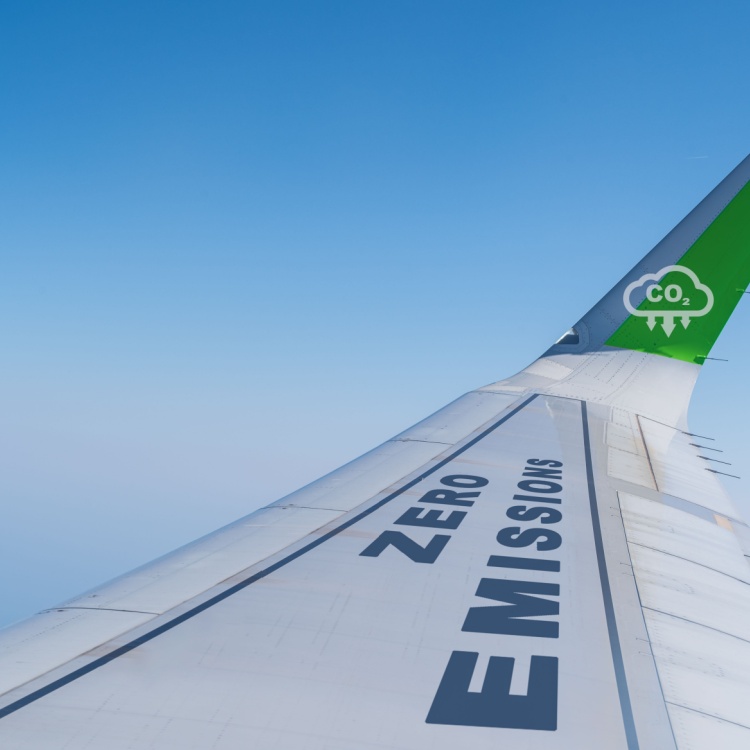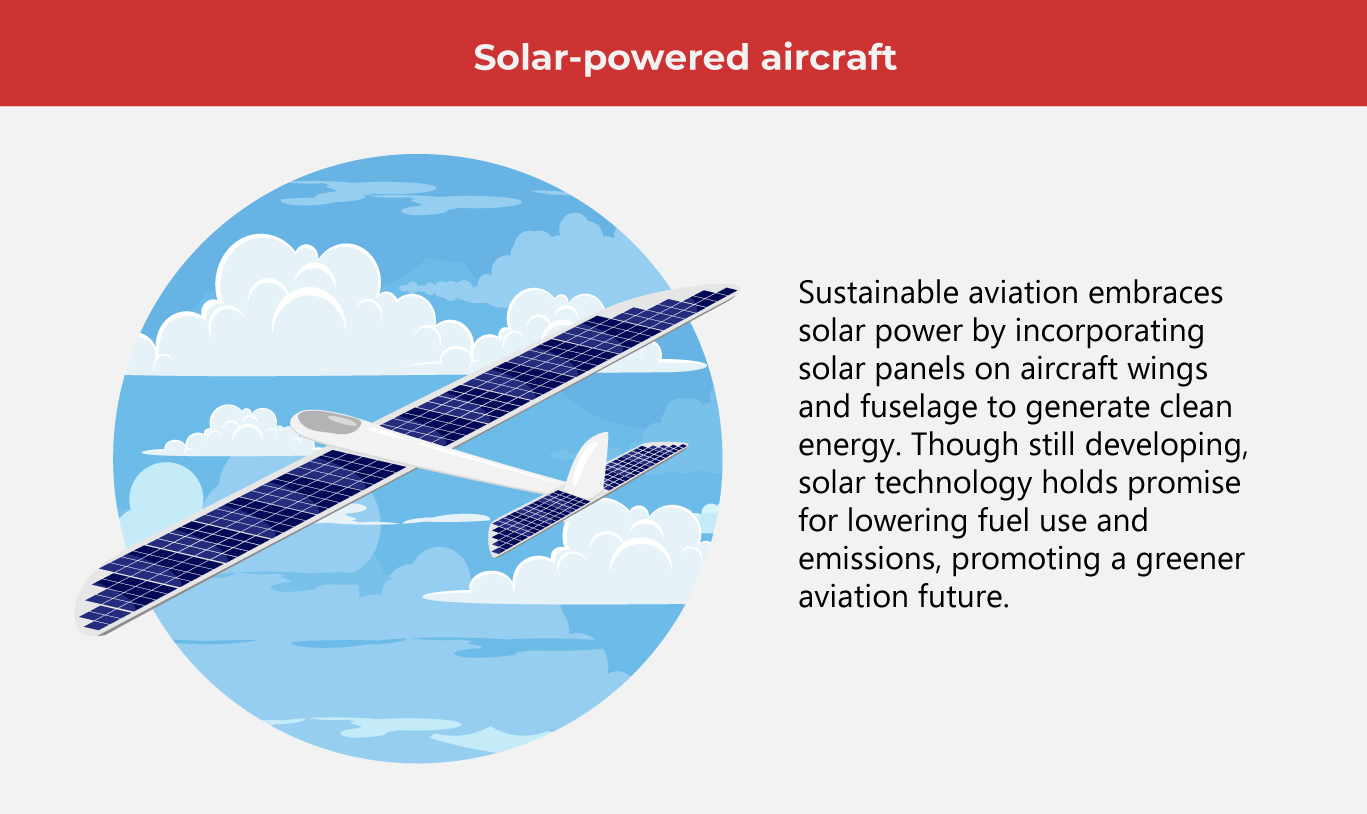The Future of Sustainable Air Travel

The World Economic Forum states that the aerospace sector, particularly aviation, faces an environmental test by committing to net-zero emissions by 2050. According to the International Air Transport Association (IATA), most of this reduction will come from sustainable fuel alternatives and carbon offset initiatives. Meanwhile, industry leaders, such as Airbus, are actively exploring low-emission solutions, including hydrogen and electric-powered aircraft, to minimize aviation’s environmental footprint.
The industry remains significantly behind schedule, highlighting the urgent need for action. Enhancing sustainability requires improving environmental indicators like fuel efficiency, load optimization, and reducing onboard waste.
As a result, airlines and manufacturers are aligning with the renewable energy market and new technologies to develop groundbreaking approaches that lower emissions.
12 Eco-friendly Innovations in Aircraft Technology
These advancements in aircraft engineering are driving innovative solutions to make air travel more sustainable and energy-efficient.
-
Vertical Take-Off and Landing (VTOL)
VTOL aircraft are transforming urban transportation with their ability to take off and land vertically, eliminating the need for runways. These innovations, powered by advanced engineering capabilities, help reduce traffic congestion and provide faster commuting options. Improvements in rotor technology, including lighter, stronger materials and better design, enhance performance, safety, and efficiency, making VTOL aircraft suitable for urban mobility and emergency services.
-
Battery advancements
For electric aircraft to become commercially viable, breakthroughs in battery technology are essential. New lithium-ion batteries are being designed with higher energy density, faster charging, and improved safety. These developments are key to enhancing electric aircraft performance and range. Additionally, product testing is exploring alternative battery options, such as solid-state batteries and hydrogen fuel cells, which could offer even better efficiency, helping electric planes compete with conventional aircraft.
-
Supersonic aviation
Supersonic flight, capable of exceeding the speed of sound, promises to revolutionize travel by significantly reducing flight times. Modern aircraft are undergoing accelerated stress tests to address challenges like noise reduction. Innovations in engine design have also led to quieter, more efficient supersonic aircraft. Specialized shapes and structures help minimize sonic booms, while improved high-speed aerodynamics enhance fuel efficiency, setting the stage for quieter high-speed travel.
-
Advanced propulsion systems
Fuel costs account for 30 to 40% of airline and airport expenses, making propulsion efficiency vital for operational efficiency. Pratt & Whitney’s geared turbofan technology improves fuel savings and reduces noise by optimizing fan speed. Meanwhile, GE Aerospace advances open fan technology, enhancing efficiency by 20%. Rolls-Royce focuses on turbine improvements, while hybrid engines blend electric and jet propulsion to cut fuel use and emissions.
-
Responsive wing structures
Cutting-edge product design and development is transforming aviation with adaptive wing technologies. These enable wings to dynamically adjust during flight. Morphing wing technology allows wings to reshape in real-time, improving aerodynamics, cutting drag, and boosting fuel economy. Similarly, variable geometry wings adapt their structure to meet specific flight needs, ensuring better maneuverability and versatility across various speeds, altitudes, and flight phases.
-
Next-gen materials
Modern aircraft rely on innovative materials that enhance strength and durability, and reduce weight. Carbon fiber composites, known for their exceptional strength-to-weight ratio and resistance to fatigue and corrosion, are used in critical components like fuselages and wings. Additionally, nanostructured materials provide superior mechanical properties such as hardness and wear resistance. Through advanced material testing, these technologies ensure improved performance and fuel savings.
-
Laser-powered propulsion
System integration is driving groundbreaking advancements in aviation propulsion technologies. Directed energy propulsion systems, which use concentrated light beams, eliminate the need for traditional fuels. Laser ignition systems enhance this integration by precisely igniting fuel-air mixtures, boosting combustion efficiency and reducing emissions. These innovations, still in experimental stages, highlight the potential for aviation to achieve unprecedented performance and sustainability.
-
Pilotless navigation
Camera design and technology is advancing unmanned flight controls, enabling aircraft to operate remotely without onboard pilots. These systems use sophisticated cameras to manage critical tasks such as navigation, take-off, and landing with precision. By eliminating risks to human pilots, they are supporting long-endurance missions. However, for seamless integration into commercial airspace, challenges like cybersecurity vulnerabilities and regulatory compliance need to be addressed to ensure operational safety.
-
AI-driven navigation
Autonomous piloting technologies, supported by precision machinery, are ushering in an era of automation. These advancements enhance flight operations by integrating AI-based systems that process vast data streams in real-time. Using advanced algorithms, aircraft can adjust to environmental shifts and navigate hazards. This technological leap also boosts flight safety while optimizing fuel consumption. As technology advances, autonomous aviation moves closer to becoming a reality.
-
Sustainable aviation fuels (SAFs)
Aviation is shifting toward sustainability, with manufacturing solutions driving advancements in fuel technology. SAFs offer a cleaner alternative, cutting CO₂ emissions by up to 80%. Developments like hydrogen-powered engines and carbon capture methods are transforming the industry. With production doubling annually, SAFs could account for 65% of aviation’s emissions reductions by 2050. However, large-scale adoption requires unified policy support and immediate investment in greener fuel alternatives.
-
Connected aircraft
With connected aircraft technology, planes use satellite communication to exchange data with ground stations and other aircraft, ensuring seamless coordination. Real-time data streaming allows continuous monitoring of flight conditions, enabling proactive maintenance and swift issue resolution. By integrating these, airlines achieve manufacturing excellence, improving efficiency, safety, and performance. With real-time insights, airlines can address technical concerns before they escalate, reducing downtime and improving overall reliability.
-
3D printing
3D printing is transforming manufacturing capabilities in aviation by streamlining part production, maintenance, and replacement. This technology enhances engine component design, allowing for lighter, more durable parts with superior thermal properties, boosting fuel efficiency. On-demand printing reduces inventory costs by enabling airlines to produce spare parts as needed, eliminating long lead times and waste. This also ensures efficient maintenance, minimizes aircraft downtime, and supports a more responsive supply chain.
 Aircraft technology is evolving rapidly, transforming the future of aviation. With a strong emphasis on sustainability, efficiency, and safety, the industry is poised to reach new heights, paving the way for a more advanced and eco-friendly future in aviation.
Aircraft technology is evolving rapidly, transforming the future of aviation. With a strong emphasis on sustainability, efficiency, and safety, the industry is poised to reach new heights, paving the way for a more advanced and eco-friendly future in aviation. As one of the Top 20 EMS companies in the world, IMI has over 40 years of experience in providing electronics manufacturing and technology solutions.
As one of the Top 20 EMS companies in the world, IMI has over 40 years of experience in providing electronics manufacturing and technology solutions.
We are ready to support your business on a global scale.
Our proven technical expertise, worldwide reach, and vast experience in high-growth and emerging markets make us the ideal global manufacturing solutions partner.
Let's work together to build our future today.
Other Blog



